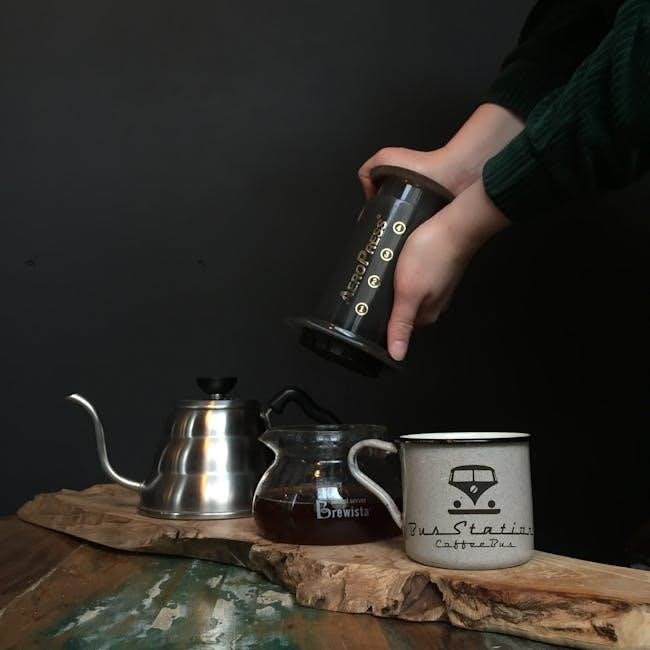Coffee filters come in various sizes and shapes, each designed for specific brewing methods. Understanding the right size ensures optimal extraction, flavor, and convenience for your coffee routine.
1.1 Overview of Coffee Filters
Coffee filters are essential accessories for brewing coffee, available in various shapes, sizes, and materials. They are designed to fit specific coffee makers, ensuring optimal extraction and flavor. Common shapes include cone-shaped, basket, and flat filters, each suited for different brewing methods like pour-over, drip, or French press. Filters also come in materials such as paper, metal, or cloth, offering unique benefits. Sizes range from No.1 for single-serve to No.6 for larger capacities, catering to diverse coffee-making needs. Choosing the right filter enhances the brewing process, ensuring a balanced and aromatic coffee experience every time.
1.2 Importance of Choosing the Right Size
Choosing the right coffee filter size is crucial for achieving optimal brewing results; A filter that is too small may lead to overflow or uneven extraction, while one that is too large can result in poor fit and improper saturation of grounds. Properly sized filters ensure balanced extraction, preventing under- or over-extraction, which can significantly impact the flavor profile of your coffee. Additionally, the right size ensures compatibility with your coffee maker, maintaining performance and consistency. Selecting the correct filter size is essential for a smooth, aromatic, and flavorful coffee experience tailored to your brewing method.
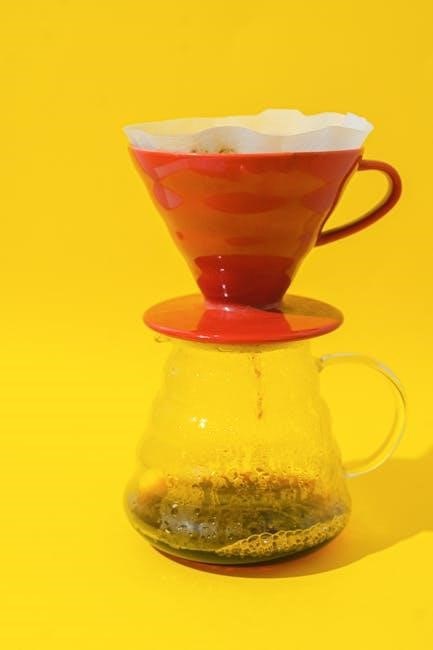
Common Coffee Filter Shapes and Sizes
Coffee filters come in cone, basket, and flat shapes, each designed for specific brewing methods. Sizes vary to accommodate different capacities, ensuring proper fit and extraction.
2.1 Cone-Shaped Filters
Cone-shaped filters are popular for pour-over and single-serve coffee makers. They come in sizes like No.1 for single cups and No.2 for 2-6 cup brewers. These filters allow precise control over extraction, enhancing flavor and aroma. Made from paper, metal, or cloth, they fit specific brewers, ensuring optimal performance. Their design promotes even water flow, crucial for balanced extraction. Cone filters are ideal for those seeking a bold, aromatic coffee experience with manual or electric brewing methods. Proper size selection is key for the best results.
2.2 Basket Filters
Basket filters are commonly used in automatic drip coffee makers and are typically round and flat. They come in standard sizes, ranging from 8 to 12 inches, with junior-sized options for smaller machines. These filters are designed to fit specific brewers, ensuring even extraction and consistent flavor. Available in paper, metal, or cloth materials, basket filters are convenient and easy to use. Paper filters are disposable, while metal and cloth options are reusable, offering durability and cost savings. They are ideal for everyday brewing, providing a smooth and balanced coffee experience.
2.3 Flat Filters
Flat filters, also known as basket-style filters, are designed for use in automatic drip coffee makers. They are typically round and flat, fitting snugly into the machine’s filter basket. These filters are usually available in standard sizes, ranging from 8 to 12 inches in diameter, with smaller junior sizes for compact brewers. Flat filters are made from paper, metal, or cloth materials, each offering unique benefits. Paper filters are disposable and convenient, while metal and cloth options are reusable, providing long-term cost savings. They ensure even extraction and consistent flavor, making them a practical choice for everyday brewing.

Standard Coffee Filter Sizes
Standard coffee filter sizes include No.1, No.2, No.4, and No.6, each designed for specific brewer capacities. No.2 is ideal for 4-6 cup brewers, while No.4 suits larger machines, ensuring proper extraction and flavor consistency.
3.1 No.1 Filter Size
The No.1 filter size is designed for single-serve or small pour-over coffee makers, typically brewing 1-2 cups. It fits most electric and non-electric single-serve brewers, offering precise control over extraction. Ideal for coffee enthusiasts who value bold flavors, this size ensures a concentrated brew. Made from paper, metal, or cloth, No.1 filters are compact and easy to use. They are perfect for those who prefer a strong, aromatic coffee without the hassle of larger filters. Always check compatibility with your specific brewer to ensure the best results and flavor consistency.
3.2 No.2 Filter Size
The No.2 filter size is ideal for brewing 2-6 cups of coffee, making it a versatile choice for medium-sized coffee makers. It is commonly used in drip brewers and pour-over systems, offering a balanced extraction for smooth flavors. Suitable for both electric and manual brewers, this size is perfect for households or offices needing a moderate amount of coffee. Available in paper, metal, or cloth materials, No.2 filters provide flexibility and convenience. Always ensure compatibility with your coffee maker to achieve the best results and maintain consistent flavor quality in every brew.
3.3 No.4 Filter Size
The No.4 filter size is designed for larger brewing capacities, typically used in coffee makers that produce 8-12 cups. It is ideal for households or offices with higher coffee consumption. This size is commonly found in standard drip coffee makers and some pour-over systems. The No.4 filter ensures even extraction and balanced flavor for larger batches. Available in various materials like paper, metal, or cloth, it offers durability and convenience. Always match this filter size with your coffee maker’s capacity to avoid overflow and ensure optimal brewing performance for a perfect cup every time.
3.4 No.6 Filter Size
The No.6 filter size is ideal for larger coffee makers, typically designed for 8-12 cup capacities. It is commonly used in standard drip coffee makers and some pour-over systems. This size ensures even extraction and balanced flavor for larger batches. Available in paper, metal, or cloth materials, the No.6 filter offers versatility for different brewing preferences; Its larger capacity makes it perfect for households or offices with higher coffee demands. Always ensure the No.6 filter matches your coffee maker’s capacity to avoid overflow and achieve optimal brewing performance for a smooth and flavorful cup of coffee every time.
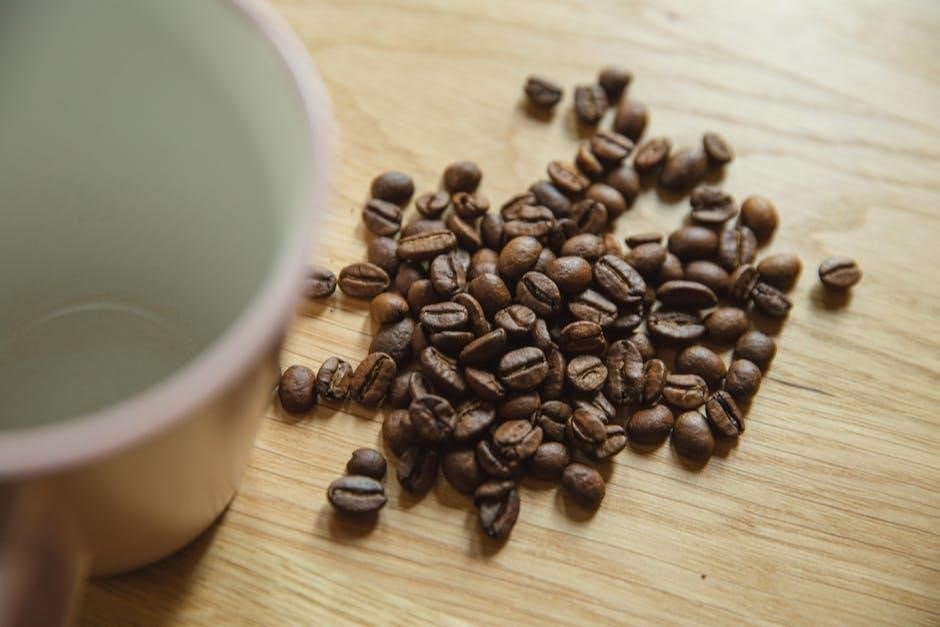
Coffee Filter Materials
Coffee filters are made from paper, metal, or cloth, each offering unique brewing benefits. Paper ensures clean extraction, metal provides durability, and cloth enhances flavor.
4.1 Paper Filters
Paper filters are a popular choice for coffee brewing due to their convenience and ability to absorb oils and residue. Available in sizes like No.1 to No.6, they suit various brewers. Disposable and easy to use, paper filters ensure a clean extraction. They come in bleached or unbleached options, with the latter offering a more natural flavor. Ideal for drip and pour-over methods, paper filters prevent coffee grounds from entering the pot, ensuring a smooth and balanced taste. Their versatility and effectiveness make them a staple in many coffee enthusiasts’ brewing routines.
4.2 Metal Filters
Metal filters are reusable, durable, and eco-friendly alternatives to paper filters. They allow coffee oils and sediment to pass through, resulting in a richer, more full-bodied flavor; Cleaning and rinsing are essential to prevent residue buildup. Metal filters are compatible with specific brewers and methods, offering consistent extraction; They are a great option for those seeking to reduce waste and enjoy a bolder coffee taste. With proper care, metal filters can last for years, making them a cost-effective and sustainable choice for coffee enthusiasts. Their versatility and longevity make them a popular choice among coffee lovers.
4.3 Cloth Filters
Cloth filters are a popular choice for coffee brewing due to their eco-friendly and reusable nature. Made from materials like cotton or hemp, they allow coffee oils and fine particles to pass through, resulting in a richer, more nuanced flavor. Cloth filters require regular cleaning and maintenance to prevent mold and residue buildup. They are often used in pour-over, French press, and cold brew methods, offering a sustainable alternative to paper filters. While they may require more care, cloth filters provide a unique taste experience and reduce waste, making them a great option for environmentally conscious coffee lovers.
Brewing Methods and Filter Sizes
Different brewing methods require specific filter sizes for optimal performance. Drip coffee makers often use standard sizes, while pour-over methods prefer cone-shaped filters. The guide helps match them perfectly.
5.1 Drip Coffee Makers
Drip coffee makers rely on specific filter sizes to ensure smooth brewing. Standard filters, like No.2 for 2-6 cups and No.4 for larger batches, are commonly used. These flat or cone-shaped filters are designed to fit snugly in the machine’s basket, allowing for even extraction. Using the correct size prevents overflow and ensures balanced flavor. Paper filters are most common, but metal and cloth options are also available, each offering unique benefits. Choosing the right filter size and material optimizes brewing performance and coffee quality for drip coffee enthusiasts.
5.2 Pour-Over Coffee Makers
Pour-over coffee makers typically use cone-shaped filters, which come in sizes like No.1 for single-cup brewers and No.2 for 2-6 cup brewers. These filters allow precise control over extraction, enabling a bold and aromatic coffee experience. The conical shape promotes even water flow and flavor distribution. Paper, metal, and cloth filters are popular options, with paper being the most common for its convenience and clean taste. Choosing the right size ensures optimal performance and flavor for pour-over enthusiasts seeking a customizable brewing process.
5.3 French Press Coffee Makers
French Press coffee makers typically do not use paper or cone-shaped filters. Instead, they rely on a metal or nylon mesh filter that allows coffee grounds to steep directly in hot water. This design enables a bold, rich flavor with more oils and sediment present in the coffee. While some French Press users opt for disposable paper filters for a cleaner taste, the traditional method emphasizes the immersive extraction process without a dedicated filter size. The lack of a standard filter size highlights the versatility and simplicity of French Press brewing, focusing on coarse coffee grounds and steeping time for flavor customization.
Determining the Right Filter Size for Your Brewer
Choosing the correct filter size is crucial for optimal brewing performance. Measure your coffee maker’s capacity and match it with the appropriate filter size for consistent results.
6.1 Measuring Your Coffee Maker’s Capacity
To determine the right filter size, start by measuring your coffee maker’s capacity. Check the manufacturer’s guidelines or physically measure the water reservoir and brew basket. This ensures you select a filter that fits perfectly, preventing overflow or under-extraction. For drip brewers, capacity often ranges from 4 to 12 cups, while pour-over and French press methods may require smaller or larger filters based on the brewing volume. Accurate measurement is key to achieving the best flavor and convenience in your brewing process.
6.2 Matching Filter Size to Brewer Capacity
Matching the filter size to your brewer’s capacity ensures optimal performance. For example, a No.2 filter is ideal for 2-6 cup brewers, while a No.4 suits 8-12 cup machines. Proper fit prevents overflow and under-extraction, guaranteeing balanced flavor.
Always consult your coffee maker’s manual for size recommendations. Using the correct filter size enhances brewing efficiency and consistency, ensuring every cup meets your expectations for taste and quality.
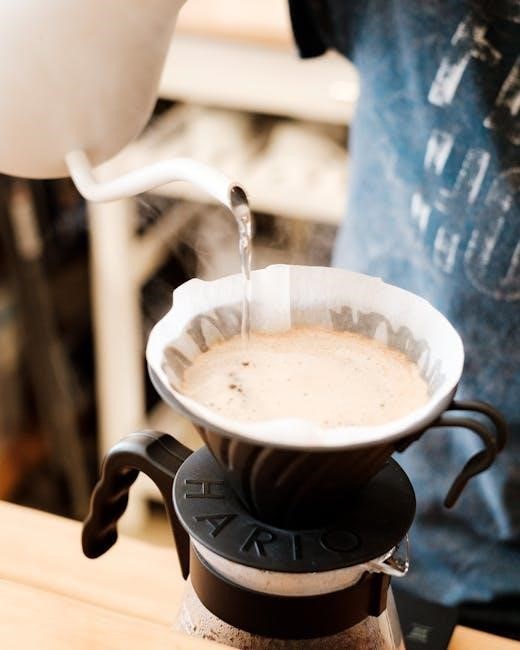
How Filter Size Affects Coffee Taste
Coffee filter size impacts extraction rates, influencing the flavor profile. Proper sizing ensures balanced extraction, preventing under- or over-extraction for a smoother, more flavorful cup of coffee.
7.1 Extraction and Flavor Profile
The size of the coffee filter directly impacts the extraction process, which in turn affects the flavor profile of the brewed coffee. Properly sized filters ensure even water flow, preventing under- or over-extraction. A filter that is too small may restrict water flow, leading to under-extraction and a weaker taste. Conversely, a filter that is too large may allow water to pass through too quickly, resulting in under-extracted coffee. The right size ensures balanced extraction, delivering a smooth and flavorful cup. Filter shape also plays a role, with cone-shaped filters promoting even extraction for a cleaner taste, while flat filters may enhance body and complexity. Additionally, the material of the filter, whether paper, metal, or cloth, influences the flavor by retaining or allowing certain oils and solids to pass through, further shaping the coffee’s character. Thus, choosing the correct filter size is crucial for achieving the desired flavor profile in your brew.
7.2 The Role of Filter Material
Filter materials significantly impact coffee flavor. Paper filters absorb oils and solids, producing a cleaner taste. Metal filters allow oils to pass through, resulting in a bolder, richer flavor. Cloth filters offer a balance, enabling some oil passage while being reusable. Each material affects the coffee’s profile differently, so choosing the right one depends on the desired taste. This variability allows coffee enthusiasts to customize their brewing experience based on personal preferences.
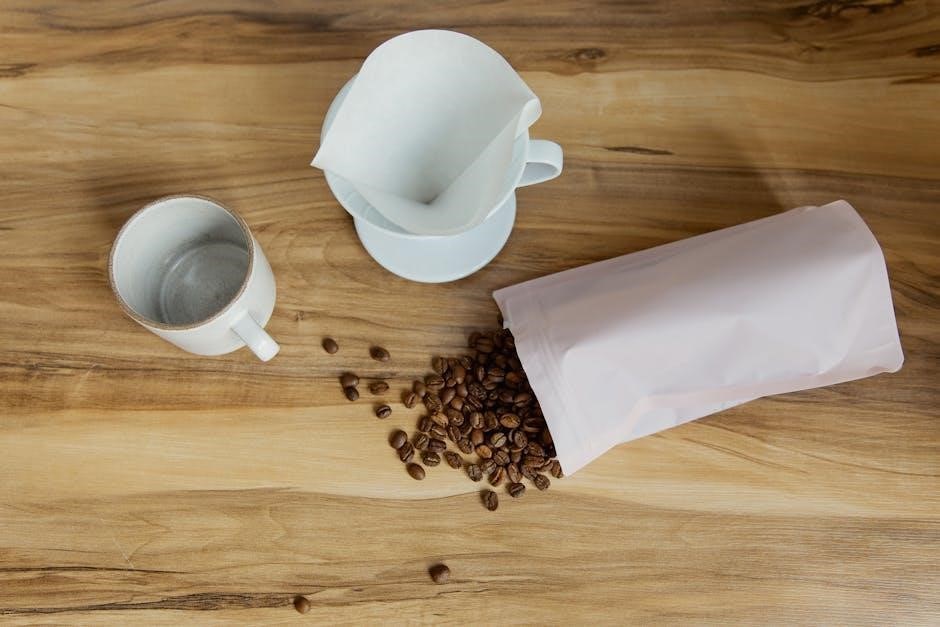
Care and Maintenance of Coffee Filters
Proper care ensures longevity and performance. Paper filters are disposable, while metal and cloth filters require regular cleaning to prevent residue buildup and maintain flavor integrity.
8.1 Storing Coffee Filters Properly
Storing coffee filters correctly ensures they remain fresh and functional. Paper filters should be kept in a cool, dry place, away from moisture and direct sunlight. For reusable filters, such as metal or cloth, rinse thoroughly after each use and allow them to air dry completely to prevent mold or bacteria growth. Avoid storing filters near strong-smelling foods, as they can absorb odors. For optimal freshness, keep filters in their original packaging or a sealed container until ready to use. Proper storage maintains their quality and ensures consistent brewing performance over time.
8.2 Cleaning and Reusing Filters
Cleaning and reusing coffee filters can be eco-friendly and cost-effective, but it requires attention to detail. Paper filters are typically single-use due to their absorbent nature and potential impact on flavor. Cloth and metal filters, however, can be reused after thorough cleaning. For cloth filters, rinse with hot water and occasionally wash with mild soap, ensuring no residue remains. Metal filters can be scrubbed and rinsed under hot water for easy maintenance. Proper drying is crucial to prevent bacterial growth and mold. While reusing filters can reduce waste, it’s important to balance convenience, taste, and hygiene. Always prioritize cleaning methods that maintain the quality and safety of your coffee.
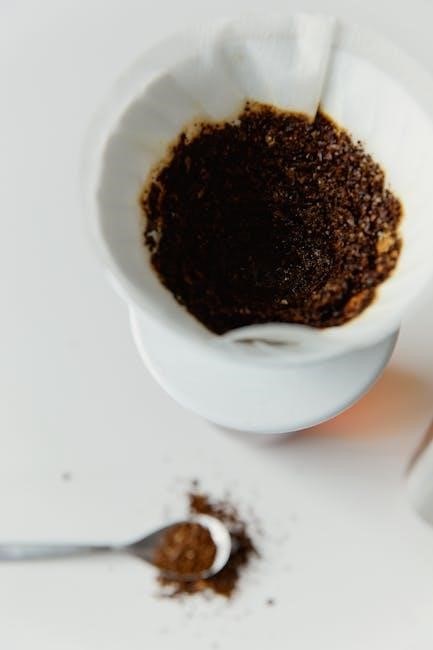
Advantages of Using the Correct Filter Size
Using the right filter size enhances efficiency, ensures even extraction, and prevents grounds from entering the coffee. It also optimizes flavor and reduces waste, improving overall brewing quality.
9.1 Optimal Brewing Performance
Using the correct coffee filter size ensures optimal brewing performance by allowing even extraction and proper water flow. A well-fitting filter prevents coffee grounds from escaping into the brew, reducing bitterness and sediment. It also enables consistent saturation of the grounds, which is crucial for balanced flavor. The right size avoids issues like channeling or under-extraction, ensuring every cup meets your expectations. This precision makes the brewing process more efficient and reliable, delivering a superior coffee experience every time. Proper fit is key to unlocking the full potential of your coffee maker and the coffee itself.
9.2 Consistency in Coffee Flavor
Consistency in coffee flavor is achieved when the right filter size is used, as it ensures even extraction and balanced flavor profiles. Properly sized filters prevent over-extraction or under-extraction, which can lead to bitter or weak coffee. By maintaining consistent water flow and ground saturation, the correct filter size helps replicate the same great taste every time. This reliability is especially important for coffee enthusiasts who value a predictable and enjoyable brewing experience.
Improperly sized filters can disrupt this balance, leading to inconsistent flavors. Using the correct size ensures your coffee tastes as intended, every brew, every time.
Choosing the right coffee filter size is crucial for optimal brewing performance and consistent flavor. Understanding the differences in shape, material, and size helps you make informed decisions, ensuring every cup meets your standards. Explore and find the perfect fit for your brewing needs!
10.1 Final Thoughts on Coffee Filter Sizes
Choosing the right coffee filter size is essential for achieving the perfect brew. Whether you prefer a bold pour-over or a smooth drip coffee, the size and material of your filter play a significant role in extraction and flavor. By understanding your brewing method and coffee maker’s capacity, you can select the ideal filter to enhance your coffee experience; Experiment with different options to find what works best for you, and remember, the right filter size ensures consistency and quality in every cup. Happy brewing!

